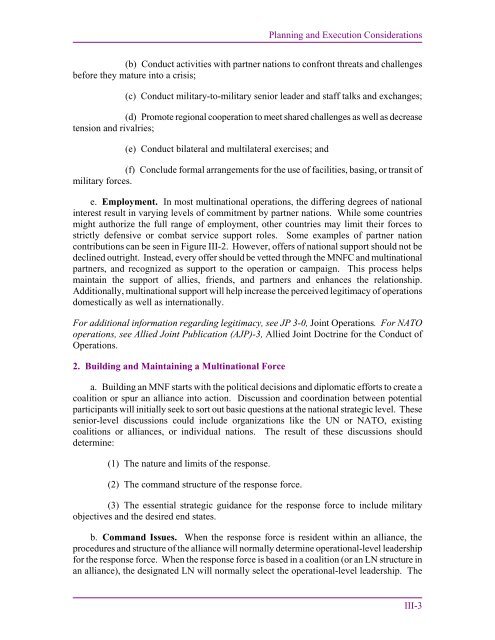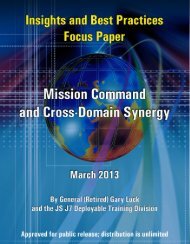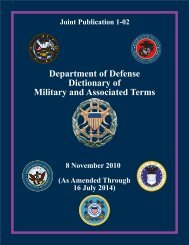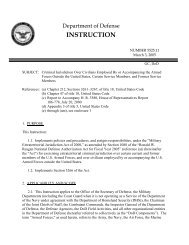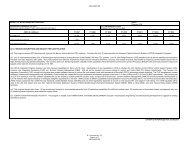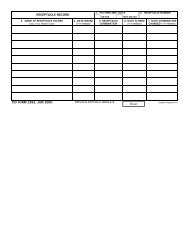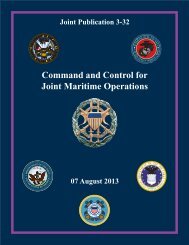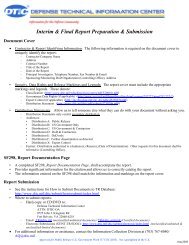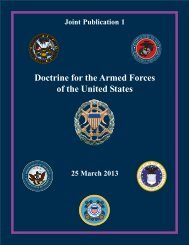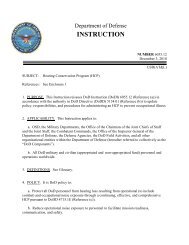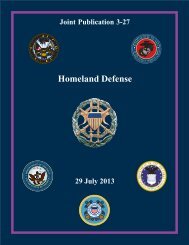JP 3-16, Multinational Operations - Defense Technical Information ...
JP 3-16, Multinational Operations - Defense Technical Information ...
JP 3-16, Multinational Operations - Defense Technical Information ...
You also want an ePaper? Increase the reach of your titles
YUMPU automatically turns print PDFs into web optimized ePapers that Google loves.
Planning and Execution Considerations<br />
(b) Conduct activities with partner nations to confront threats and challenges<br />
before they mature into a crisis;<br />
(c) Conduct military-to-military senior leader and staff talks and exchanges;<br />
(d) Promote regional cooperation to meet shared challenges as well as decrease<br />
tension and rivalries;<br />
(e) Conduct bilateral and multilateral exercises; and<br />
(f) Conclude formal arrangements for the use of facilities, basing, or transit of<br />
military forces.<br />
e. Employment. In most multinational operations, the differing degrees of national<br />
interest result in varying levels of commitment by partner nations. While some countries<br />
might authorize the full range of employment, other countries may limit their forces to<br />
strictly defensive or combat service support roles. Some examples of partner nation<br />
contributions can be seen in Figure III-2. However, offers of national support should not be<br />
declined outright. Instead, every offer should be vetted through the MNFC and multinational<br />
partners, and recognized as support to the operation or campaign. This process helps<br />
maintain the support of allies, friends, and partners and enhances the relationship.<br />
Additionally, multinational support will help increase the perceived legitimacy of operations<br />
domestically as well as internationally.<br />
For additional information regarding legitimacy, see <strong>JP</strong> 3-0, Joint <strong>Operations</strong>. For NATO<br />
operations, see Allied Joint Publication (A<strong>JP</strong>)-3, Allied Joint Doctrine for the Conduct of<br />
<strong>Operations</strong>.<br />
2. Building and Maintaining a <strong>Multinational</strong> Force<br />
a. Building an MNF starts with the political decisions and diplomatic efforts to create a<br />
coalition or spur an alliance into action. Discussion and coordination between potential<br />
participants will initially seek to sort out basic questions at the national strategic level. These<br />
senior-level discussions could include organizations like the UN or NATO, existing<br />
coalitions or alliances, or individual nations. The result of these discussions should<br />
determine:<br />
(1) The nature and limits of the response.<br />
(2) The command structure of the response force.<br />
(3) The essential strategic guidance for the response force to include military<br />
objectives and the desired end states.<br />
b. Command Issues. When the response force is resident within an alliance, the<br />
procedures and structure of the alliance will normally determine operational-level leadership<br />
for the response force. When the response force is based in a coalition (or an LN structure in<br />
an alliance), the designated LN will normally select the operational-level leadership. The<br />
III-3


